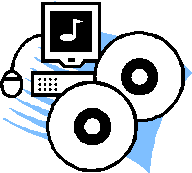Math Topics
Learning Support
Professional
![]()
 Our
collection of products to help your students master mathematical
concepts continues to grow. Special thank-you to those parents
and educators who email their suggestions.
Our
collection of products to help your students master mathematical
concepts continues to grow. Special thank-you to those parents
and educators who email their suggestions.
After viewing our list of titles, link to details. The product descriptions and additional comments provided are intended to serve as a guide for software selection. Correlations to national and state standards are provided where possible, as well as contact information.
Email us directly with your favorite math title and publisher and a few words on why you really like the software.
Evaluate and tell us about the instructional, assessment, and technical features of the math software and apps you use.
Need More Information? See...
![]()
 Many of the software titles included in our software index are
being used in districts in Ohio and across the U.S. Our database
began with a list of software products collected from a survey of 13
mid-sized urban districts in Ohio during 1999-2000.
Many of the software titles included in our software index are
being used in districts in Ohio and across the U.S. Our database
began with a list of software products collected from a survey of 13
mid-sized urban districts in Ohio during 1999-2000.
Patricia Deubel spoke with software developers, school administrators, technology coordinators, and teachers to learn about products they were using to prepare students for Ohio's high school graduation test in mathematics. CT4ME does ongoing research to upgrade the list and keep it current.
The software titles for this project have been gathered in four ways.
| Survey Titles | Software titles were included on the Ohio Ninth Grade Proficiency Test Mathematics Impact Survey. This survey was used in a 1999-2000 study Mathematics Software and Achievement on the Ohio Ninth Grade Proficiency Test, which received support from the Ohio Department of Education (ODE) Urban Schools Initiative. The study measured the impact of software use on preparing grade 8 students for their first attempt to pass Ohio's required graduation math test. See a summary of this research listed in our section for Papers: The good and bad news of software use for mathematics proficiency test preparation. |
| Other Titles Used | Teachers who were surveyed suggested other commercial and Internet software titles they used to help prepare students for the March 2000 math test. |
| Software Wish List | Teachers suggested software titles they wanted to use, but were not able to do so because cost was over the budget of their school or computers were not powerful enough. Some titles were of interest to special education math teachers. |
| Ongoing Research | This is an ongoing project to help teachers to select the best software products, which help students to learn math concepts and to prepare them to pass math standardized tests.
Send us an email with your favorite math title. |
Douglas Reeves (2006) reminded us that "the cause of success in improving student achievement is not the brand name of the product but the degree of implementation by the teacher" (p. 78). Effective monitoring includes "not only frequency but also the specification of the levels of implementation" (p. 78).
 Before you commit your school dollars to purchasing any ed-tech,
consider the ten tips for
How to Avoid Getting Ripped Off by Ed-Tech Vendors by Rob
Waldron, an industry leader (2018, Winter). It's eye-opening with sufficient
detail to assist with making decisions. Briefly:
Before you commit your school dollars to purchasing any ed-tech,
consider the ten tips for
How to Avoid Getting Ripped Off by Ed-Tech Vendors by Rob
Waldron, an industry leader (2018, Winter). It's eye-opening with sufficient
detail to assist with making decisions. Briefly:
Waldron concluded by reminding districts to choose vendors who can adapt to change brought on by technology advancements, curriculum requirements, and "new government requirements or guidelines."
Tara Mathewson and Sarah Butrymowicz (2020) of The Hechinger Report cautioned school leaders to be wary of claims by ed tech companies regarding the effectiveness of their products in raising the achievement of learners. Their claims of "proven" results, based on research, might appear on their websites, in product brochures, or in email pitches. However, those claims might be based on "shoddy research." The authors indicated they have found dozens of companies that have promoted their products in this manner. They illustrated the problem in their discussion of the claims by several companies (e.g., IXL, Matific, SuccessMaker).
Although a product might appear to work in one district, it might not be suitable for use in another. Districts are encouraged to conduct their own research. Mathewson and Butrymowicz (2020) listed the following organizations that have begun to assist districts in this endeavor:
Software is only one piece of learning. The Software & Information Industry Association (SIAA, 2007) indicated, "The following factors should be considered when planning for the use of instructional applications:
learning standards it supports
learning needs of the students for whom it is intended
current teaching methods
organization of classrooms and other learning spaces used for technology
daily instructional schedule
assessment methods for the area of learning
other technology-based programs used by the students for similar purposes
non-technology learning materials available to the students." (p. 15).
On November 8, 2006, the SIIA issued its Software Implementation Checklist for Educators, It includes 10 basic concepts for effective software implementation, the essence of which follows:
Closing the Gap has an extensive resource directory with hardware, software, other assistive technology, producers, and organizations (e.g., those in your state) that serve children and adults with special needs. You can search for software by disability, access aids, professional management, skill level, academic content area, or define your own category. Hardware can be found via disability and input/output device. Plus, you can search by product category.
Superkids.com provides reviews and ratings of educational software.
 Get guidelines to judge the instructional and technical merit of educational
software in Selecting Curriculum-Based Software
by Dr. Patricia Deubel, which was featured in Learning & Leading with Technology,
February, 2002.
Get guidelines to judge the instructional and technical merit of educational
software in Selecting Curriculum-Based Software
by Dr. Patricia Deubel, which was featured in Learning & Leading with Technology,
February, 2002.
 Checklists for accessible software are at the following:
Checklists for accessible software are at the following:
Mathewson, T., & Butrymowicz, S. (2020, May 20). Ed tech companies promise results, but their claims are often based on shoddy research. The Hechinger Report. https://hechingerreport.org/ed-tech-companies-promise-results-but-their-claims-are-often-based-on-shoddy-research/
Reeves, D. (2006). The learning leader: How to focus school improvement for better results. Alexandria, VA: ASCD.
Software & Information Industry Association (2006, November 8). Software Implementation Checklist for Educators. Washington, DC: SIIA.
Waldron, R. (2018, Winter). How to avoid getting ripped off by ed-tech vendors. Education Next, 18(1). http://educationnext.org/how-to-avoid-getting-ripped-off-ed-tech-vendors-ten-tips/
![]()
![]() See
our Math Software Titles | Use our Math Software
and App Evaluation Form
See
our Math Software Titles | Use our Math Software
and App Evaluation Form